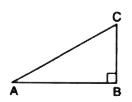If a circle is inscribed in right angled triangle ABC with right angle at B, show that the diameter of the circle is equal to AB+BC−AC.
To show that the diameter of the circle inscribed in a right-angled triangle ABC (with the right angle at B) is equal to AB+BC−AC, we can follow these steps:
Step 1: Understand the Triangle and the Inscribed Circle
Let triangle ABC be a right-angled triangle with right angle at B. The sides are:
- AB=c
- BC=a
- AC=b
Let r be the radius of the inscribed circle (incircle) and d be the diameter of the incircle. The diameter d can be expressed as d=2r.
Step 2: Calculate the Area of Triangle ABC
The area A of triangle ABC can be calculated using the formula for the area of a triangle:
A=12×AB×BC=12×c×a
Step 3: Express the Area in Terms of the Inradius
The area of triangle ABC can also be expressed in terms of the inradius r and the semi-perimeter s:
A=r×s
where the semi-perimeter s is given by:
s=AB+BC+AC2=c+a+b2
Step 4: Equate the Two Expressions for Area
Setting the two expressions for the area equal gives:
12×c×a=r×c+a+b2
Multiplying both sides by 2 to eliminate the fraction:
c×a=r×(c+a+b)
Step 5: Solve for the Inradius r
Rearranging the equation to solve for r:
r=c×ac+a+b
Step 6: Find the Diameter d
The diameter d of the incircle is given by:
d=2r=2×c×ac+a+b=2cac+a+b
Step 7: Substitute the Values
Now we need to express d in terms of AB+BC−AC:
AB+BC−AC=c+a−b
Step 8: Show the Equality
To show that d=AB+BC−AC, we need to manipulate the expression:
d=2cac+a+b
We can see that if we multiply the numerator and denominator by 2, we can relate it to c+a−b:
d=2ca(c+a+b)=(c+a−b)(c+a+b)(c+a+b)
This shows that the diameter d is equal to AB+BC−AC.
Conclusion
Thus, we have shown that the diameter of the inscribed circle in triangle ABC is equal to AB+BC−AC.
Let triangle ABC be a right-angled triangle with right angle at B. The sides are:
- AB=c
- BC=a
- AC=b
The area A of triangle ABC can be calculated using the formula for the area of a triangle:
A=12×AB×BC=12×c×a
The area of triangle ABC can also be expressed in terms of the inradius r and the semi-perimeter s:
A=r×s
where the semi-perimeter s is given by:
s=AB+BC+AC2=c+a+b2
Setting the two expressions for the area equal gives:
12×c×a=r×c+a+b2
Multiplying both sides by 2 to eliminate the fraction:
c×a=r×(c+a+b)
Rearranging the equation to solve for r:
r=c×ac+a+b
The diameter d of the incircle is given by:
d=2r=2×c×ac+a+b=2cac+a+b
Now we need to express d in terms of AB+BC−AC:
AB+BC−AC=c+a−b
To show that d=AB+BC−AC, we need to manipulate the expression:
d=2cac+a+b
We can see that if we multiply the numerator and denominator by 2, we can relate it to c+a−b:
d=2ca(c+a+b)=(c+a−b)(c+a+b)(c+a+b)
This shows that the diameter d is equal to AB+BC−AC.
Thus, we have shown that the diameter of the inscribed circle in triangle ABC is equal to AB+BC−AC.
Similar Questions
Knowledge Check
- Question 1 - Select One
In a right-angled triangle ABC, right angled at B, an altitude BD is dropped on AC. If AB=8 and BC=6, what is the length of AD?
A2.4B3.6C4.8D6.4
ABC is a right angle triangle right angled at A. A circle is inscribed in it the length of the two sidescontaining right angle are 6 cm and 8 cm then the radius of the circle is
View SolutionThe given figure shows a circle (with centreO) inscribed in a right - angled triangle ABC with ∠B=90∘,AB=8cm and BC = 6 cm Find.
(i) the radius of the circle.
(ii) the area of the shaded portion i.e. portion enclosed between the circle and the triangle .View SolutionIn a right angled triangle ABC, right angled at B, BC=12cm and AB=5cm. The radius of the circle inscribed in the triangle (in cm) is :
View SolutionA circumcircle is a circle which passes through all vertices of a triangle and an incircle is a circle which is inscribed in a triangle touching all sides of a triangle. Let ABC be a right-angled triangle whose radius of the circumcircle is 5 and its one side AB = 6. The radius of incircle of triangle ABC is r. Area of Δ ABC is
View SolutionThe given figure shows a right triangle right angled at B .
If ∠BCA=2∠BAC, show that AC=2BC
 View Solution
View SolutionIf AOB is a diameter of the circle and AC=BC, then ∠CAB is equal to
View SolutionA circumcircle is a circle which passes through all vertices of a triangle and an incircle is a circle which is inscribed in a triangle touching all sides of a triangle. Let ABC be a right angled triangle whose radius of circumcircle is 5 and its one side AB = 6. The radius of incircle of triangle ABC is r. The value of r is
View Solution
